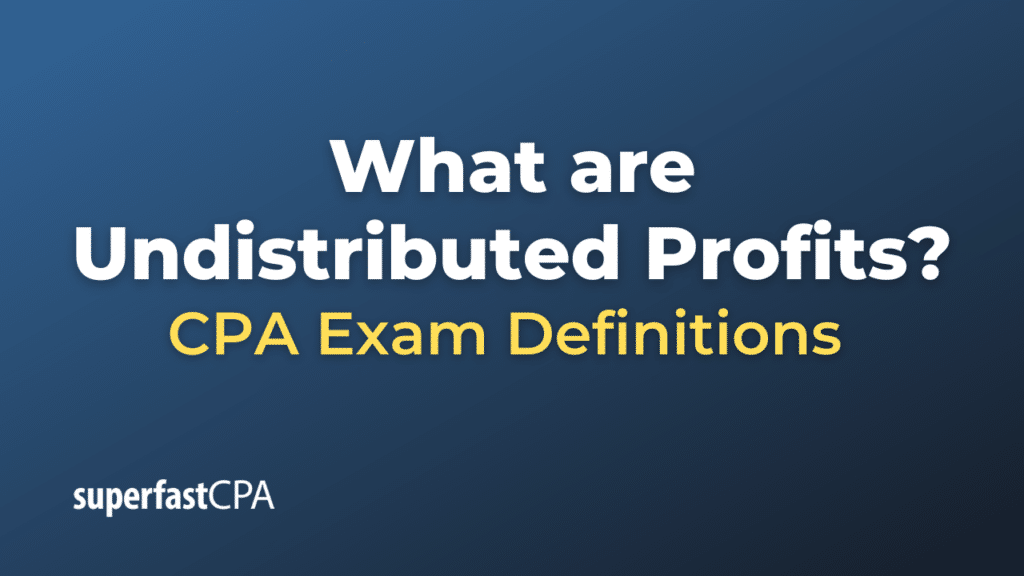Undistributed Profits
Undistributed profits, also known as retained earnings, are the portion of a company’s net income that is not paid out as dividends to shareholders but is instead retained within the company for various purposes. These purposes could include reinvestment in business operations, debt repayment, or saving for future opportunities and contingencies. Essentially, undistributed profits are profits that remain in the company’s coffers after it has met all its financial obligations, including the payment of dividends.
How are Undistributed Profits Calculated?
The general formula to calculate undistributed profits is:
Undistributed Profits (Retained Earnings) = Previous Retained Earnings + Net Income for the Period − Dividends Paid
- Previous Retained Earnings: The amount of undistributed profits carried over from the last accounting period.
- Net Income for the Period : The net income generated by the company during the accounting period under consideration.
- Dividends Paid : The total dividends paid out to shareholders during the accounting period.
Why are Undistributed Profits Important?
- Reinvestment : Companies often use undistributed profits to reinvest in business operations, including R&D, marketing, expansion, and acquisition of assets, among others. This reinvestment can drive future growth and generate higher returns in the long term.
- Financial Flexibility: Having a cushion of undistributed profits gives a company greater financial flexibility. It can use these funds for unexpected expenses, opportunities, or contingencies without having to borrow or issue new shares.
- Debt Repayment: Companies can use undistributed profits to reduce debt levels, which may improve the firm’s credit rating and decrease interest expenses, enhancing its overall financial health.
- Dividends: Retained earnings provide a source for future dividend payments, which could be particularly beneficial for attracting and retaining investors seeking regular income.
- Indication of Financial Health: A consistently growing level of undistributed profits often signals strong financial health and effective management, which can positively impact a company’s stock price.
Accounting and Reporting
The amount of undistributed profits or retained earnings is reported on a company’s balance sheet under the equity section. This amount is also often disclosed in the statement of retained earnings, which shows the changes in retained earnings over a specific accounting period.
It’s important for investors and analysts to scrutinize how a company uses its undistributed profits, as it can provide insights into the company’s growth prospects and financial stability.
Example of Undistributed Profits
Let’s consider a hypothetical example to illustrate the concept of undistributed profits. Assume we’re looking at the financials of a small tech company called “TechBuddy.”
Initial Financial Information
- Previous Retained Earnings (End of last year): $50,000
- Net Income for This Year: $30,000
- Dividends Paid This Year: $10,000
Calculating Undistributed Profits (Retained Earnings) for This Year
Using the formula:
Undistributed Profits (Retained Earnings) = Previous Retained Earnings + Net Income for the Period − Dividends Paid
We find:
Undistributed Profits (Retained Earnings) = $50,000 (Previous Retained Earnings) + $30,000 (Net Income) – $10,000 (Dividends)
= $50,000 + $30,000 – $10,000
= $70,000
Interpretation:
- Reinvestment : With $70,000 in undistributed profits, TechBuddy has additional capital it can use to reinvest in business operations, such as research & development or market expansion.
- Financial Flexibility : This sum gives TechBuddy flexibility to handle unexpected expenses or take advantage of new business opportunities without needing to take on debt or issue new shares.
- Debt Repayment : If TechBuddy has existing debt, the company can use some of these funds to pay it down, thus improving its financial health and potentially reducing interest expenses.
- Future Dividends: TechBuddy could also opt to use some of these retained earnings for future dividend payments, which would be attractive to shareholders looking for income.
Reporting:
On TechBuddy’s balance sheet, the equity section would reflect the new retained earnings (undistributed profits) of $70,000. The company might also issue a “Statement of Retained Earnings” to show the changes in retained earnings over the course of the year, including the net income earned and dividends paid.
By examining how TechBuddy utilizes its undistributed profits, stakeholders can gain valuable insights into the company’s growth prospects, financial stability, and management effectiveness.













